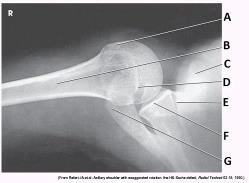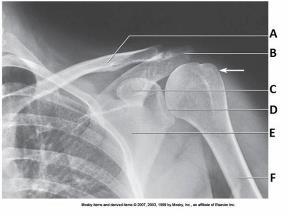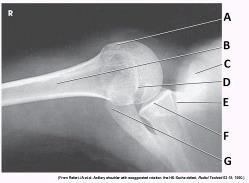Anatomy of letter B below:
Acromion
AP humerus
What is the Midpoint of the humerus
AP Shoulder Projection
0 degrees - Perpindicular
AP Shoulder Projections
Suspend Respirations
Hand position AP Shoulder, External Rotation
Supinate Hand
Anatomy labeled A in image below
Lesser Tubercle
AP shoulder
1 inch inferior to the coracoid process
PA Oblique Shoulder, Scapular Y
0 degrees, perpendicular
Lateral Projection, Humerus
Suspend Respiration
Body rotation for AP oblique Shoulder, Grashey Method
35 - 45 degrees toward affected side
Shown in profile on an AP projection of humerus
Greater tubercle
Transthoracic Lateral Shoulder
What is the surgical neck?
AP Oblique Shoulder, Grashey Method
0 degrees - Perpendicular
Inferosuperior Axial Shoulder Projection
Suspend Respiration
Arm abduction for inferosuperior shoulder projection
90 degrees
Anatomy listed as "C" below:
Coracoid Process
AP oblique shoulder, Grashey Method
2 inches medial and 2 inches inferior to the superolateral border of the shoulder
AP Axial Clavicle, Lordotic Position
0 - 15 Degrees Cephalic
PA Oblique Scapular Y Projection
Suspend
Position of Unaffected Arm for Transthoracic Lateral Shoulder
Raised with forearm on head
Anatomy of letter "G" below""
Acromion
Inferosuperior axial projection, Lawrence Method
Through the axilla to the region of the AC articulation
Inferosuperior Axial Shoulder Projection
15 - 30 degrees
Bilateral AC Joints
Suspend Respirations
Body Rotation for PA Oblique Shoulder, Scapular Y
45 - 60 Degrees
The term used for the medial aspect of the clavicle
Sternal extremity
Thransthoracic Lateral Shoulder, Arm not elevated
10-15 degrees Cephalad
AP Axial Clavicle Projection
Full Inspiration
Hand Position for Inferosuperior Axial Shoulder
External Rotation
Clavicle and Scapula
Supraspinatus "outlet" Tangential Projection, Neer Method
Entering the superior aspect of the humeral head
15 - 30 degrees Cephalic
AP Clavicle Projection
Suspend at end of Exhalation
Proper Arm Abduction for Inferosuperior Axial Projection of Shoulder
90 degrees
The lesser tubercle is located on this surface of the humerus
Anterior
Midline of the body
Lateral Projection of Scapula
0 degrees - Perpendicular
Bilateral AC Joints
Suspend Respiration
Hand position for Intertubercular Groove, Patient Supine
Supinated
A lateral scapula with arm positioned above the head will show:
Body of scapula
AP Clavicle
Midshaft of the clavicle
Supraspinatus "Outlet" Shoulder Projection, Neer Method
10 - 15 degrees Caudad
Transthoracic Lateral Shoulder, with No Breathing Technique
Full Inspiration
Two ways the patient may be positioned for AP Axial Clavicle
Standing upright or in Lordotic position
A lateral scapula with arm flexed behind patients back shows:
delineation of the acromion and the coracoid process
AP Scapula
2 inches inferior to the coracoid process
Inferosuperior Axial Projection, Lawrence Method
15 - 30 degrees
AP Scapula Projection
During slow breathing
Arm position for Lateral Scapula: to delineate body of scapula
Arm extended above head, rest forearm on head